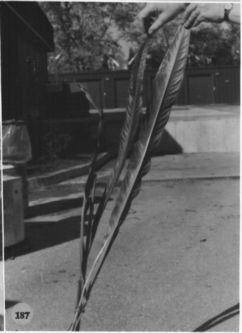




Gard. Chron. 652. 1877. TYPE: Origin unknown: Hort. Kew, Nov. 8, 1876, N. K. Brown s.n. (K).
LEAVES spreading; petioles usually triangular or sharply 3-5 ribbed; geniculum 7-10 cm long, conspicuously bulging adaxially; blades linear to linear-lanceolate, subcoriaceous, 46-80 cm long, 5.5-12.5 cm wide, broadest at middle, the margins broadly undulate; both surfaces semiglossy; the midrib scarcely raised and broad at base, narrowing and convexly raised at middle, acute nearly to apex, sunken at apex above, sharply raised below; primary lateral veins 20-30 per side, departing midrib at 40°-45° angle, straight to collective vein, sunken above, raised below; interprimary veins flat to scarcely sunken above, prominulous below; collective vein arising from near the base, 3-6 mm from the margin, sunken above, raised below.
INFLORESCENCE spreading, shorter than leaves; peduncle flattened. 2-4 ribbed, 33-48 cm long, 1-1 5 cm wide. 2 times longer than petioles; spathe coriaceous, green, lanceolate to broadly lanceolate 6.5-8 cm long, 1.7-3 cm wide, broadest below middle, shorl acuminate al apex, rounded at base, inserted at 50° angle on peduncle; spadix pale yellow to creamy white, (J.7)3-4 cm long, 0.9-1.1 cm diam. midway; flowers 4-lobed, ca. 1.4 mm long, 2.2 mm wide, the sides sigmoid; ca. 12 flowers visible in principal spiral, 15 flowers visible in the alternate spiral; tepals matte, the lateral tepals 0.7 mm wide, the inner margins straight; pistils emergent, pale yellow; stigma minute, drying before stamens emerge; lateral stamens scattered throughout before alternates appear, cxserted on fleshy filaments, held over and obscuring pistil; thecae oblong, not divaricate; pollen pale yellow fading to cream.
INFRUCTESCENCE unknown. Fig. 187.
Anthurium spathiphyllum is known from Costa Rica to Panama from sea level to 380 m (with the exception of Croat 3557 I, which was collected at 1,350 m elevation) on the Atlantic slope in welter parts of tropical moist forest and in premontane wet and tropical wet forest life zones. The species can be recognized by its epiphytic habit, chartaceous leaves, usually triangular, sometimes 3-5 ribbed petiole, lanceolate to broadly lanceolate cucullate spathe, and short, scarcely tapered, pale yellow spadix. Anthurium spathiphyllum is in section Pachyneurium and is most closely related to A. cuneatissimum. The latter species differs in having fewer, less sunken primary lateral veins (commonly 10-15 versus 20-30 for A. spathiphyllum) and m having a spathe that is ovate and about as long as the spadix (versus lanceolate to broadly lanceolate and about two times longer than the spadix in A. spathiphyllum).
 |
Map of Mesoamerican specimens with coordinates
Costa Rica Alajuela: 380 m,, 26 May 1976, Thomas B. Croat 35651 (MO,
RSA).
Costa Rica Guanacaste: 1300-1600 m, 10.48.20N 85.17.50W, 8 November
1990, Gerardo Rivera 835 (INB,MO,US).
Costa Rica Heredia: Finca La Selva, 100-150 m,, 6 Jan 1978, Thomas
B. Croat 44309 (MO).
Costa Rica Heredia: 1350 m,, 26 May 1976, Thomas B. Croat 35571 (MO).
Costa Rica Heredia: Puerto Viejo Region,, , Burger & Matta 4258
(F). Costa Rica Heredia:, , Grayum & Schatz 644 (CM).
Costa Rica Heredia: Finca La Selva, 100 m,, 15 Feb 1981, Folsom 8950
(CAS).
Costa Rica Heredia: Finca La Selva, 100 m,, , Wilbur & Jacobs 34194
(DUKE).
Costa Rica Heredia: Zona Protectora La Selva, 340 m, 10.21N 84.04W,
, Schatz & Grayum 644 (DUKE, MO).
Costa Rica Heredia: 570-700 m,, 19 Apr 1988, Kress et al. 88-2417 (SEL).
Costa Rica Heredia: Estación Biológica La Selva, 50-100
m, 10.26N 84.01W, 16 Oct 1990, Grayum 10010 (MO).
Costa Rica Lim—n: Cerro Coronel, 20-170 m, 10.41N 83.38W, 15-20 Sep
1986, Warren Douglas Stevens 24541 (MO).
Costa Rica Lim—n: 250 m,, , Thomas B. Croat 71838 (MO). Costa Rica
Lim—n: 150 m,, 30 March 1978, Ocampos 1906 (MO).
Costa Rica Lim—n: 100 m,, 8 May 1977, Ocampo 1987 (MO).
Costa Rica Lim—n: 40 m, 10.30N 83.47W, 30 Aug 1979, Davidson &
Donahue 8954 (MO).
Costa Rica Lim—n: Río Parismina,, , Lent 2444 (F).
Costa Rica Lim—n: 100 m, 10.24N 83.33W, 11 August 1988, Rafael Robles
Gerardo Herrera & Luis Flores 2003 (MO).
Costa Rica Puntarenas: Parque Nacional Corcovado,, 6 February 1981,
Tellez et al. 4248 (MEXU, MO).
Costa Rica San José: P.N. Braulio Carrillo, 600-700 m,, 18 Feb 1983,
Chacon 338 (MO). Costa Rica San José: 200 m,, 26-30 April 1977, Ocampo
1625 (CR).
Costa Rica San José: 300 m,, 26-30 April 1977, Ocampo 1624 (CR).
Nicaragua Río San Juan: 120 m, 11.01N 084.14W, 4 Enero 1997, Ricardo
Rueda, Indiana Coronado, Oscar Aráuz & Franklin Flores 5378
(MO).
Nicaragua Zelaya: 8-10 m, 13.29N 84.13W, 26 Apr. 1978, W.D. Stevens
8255 (MO).
Nicaragua Zelaya: Kururia, 50 m, 14.41N 84.4W, 3 March 1979, Pipoly
3968 (MO).
Nicaragua Zelaya: 200 m, 14.39N 84.04W, 2 March 1979, J. Pipoly 3830
(MO).
Nicaragua Zelaya: 200 m, 14.39N 84.04W, 2 March 1979, J. Pipoly 3743
(MO).
Nicaragua Zelaya: 50-100 m, 13.58N 84.12W, 30 Apr. 1978, W.D. Stevens
8504 (MO).
Nicaragua Zelaya: Risco de Oro, 40 m,, 22 Mar. 1979, Pipoly, J. 5021
(MO).
Panama Bocas del Toro:, 26 July 1971, Croat & Porter 16276 (MO).
Panama Bocas del Toro:, , Blum 1403 (FSU, SCZ). Panama Bocas del Toro:,
, Kennedy 1273 (DUKE).
Panama CoclŽ:, 11 Apr. 1969, Lewis et al. 5569 (MO).
Map of South American Specimens with coordinates
Ecuador Esmeraldas: Bilsa, 400-600 m, 00.21N 79.44W, 20 May 1995, John L. Clark & Clare Watt 949 (QCNE, MO).